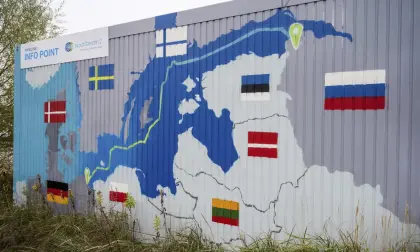Explosions in the Baltic Sea are thought to be linked to the sudden appearance of leaks in the controversial Nord Stream gas pipelines, which have been at the forefront of an energy battle between Russia and Europe since Moscow’s invasion of Ukraine.
The dramatic incident has put the gas pipelines running from Russia to Germany back in focus, and highlighted the vulnerabilities of the continent’s crucial infrastructure.
JOIN US ON TELEGRAM
Follow our coverage of the war on the @Kyivpost_official.
– What caused the leaks? –
The near simultaneous appearance on Monday of leaks on the three pipelines that make up Nord Stream 1 and 2 has prompted suspicions that the incident was caused deliberately.
“I can hardly imagine any possibility of three separate gas pipes springing a leak one after the other, unless it is sabotage,” Johan Lilliestam, researcher at the Potsdam Institute for Advanced Sustainability Studies, told AFP.
An accident scenario was all the more unlikely as the pipelines are made with heavily resistant steel.
Nord Stream 1, in service since 2011, has never reported any similar incidents, while Nord Stream 2 is brand new.
Poland and Denmark’s authorities have decried the incident as an “act of sabotage”.
While Russia has said it was “extremely concerned” about the leaks, some experts say Moscow could itself have had a hand in the incident.
Russia could have used “sabotage as a pretext to stop gas deliveries”, said Tor Ivar Strommen, researcher at the Royal Norwegian Naval Academy.
Simone Tagliapietra of the Bruegel economic think tank said reasons supporting the thesis of a Russian attack would be for Moscow to “create further stress in the EU gas market”.
“Or as a signal that Russia is breaking forever with Western Europe and Germany,” said the researcher, noting that it “would be a symbolic” move given that Poland inaugurated its pipeline with Norway on Tuesday.
A deliberate sabotage could also act as a “signal to other countries to scare them”, Strommen told AFP.
“What happened in the Baltic Sea is also possible in the North Sea and the Mediterranean Sea,” said Sebastian Herold from the Darmstadt University of Applied Sciences.
“Natural gas supplies from Norway and Algeria are also vulnerable.”
Already, Russia has used its position as a fossil fuel exporter to turn the screws on its Western customers, dwindling supplies and thereby pushing up prices.
Inflation in Europe has soared and governments have rushed to find alternative supplies of energy and provide support for under pressure households and business.
– How does it affect supply? –
As both pipelines are not in use, there is no immediate impact to supplies.
Though completed, the Nord Stream 2 pipeline has never gone into use. The controversial energy link, for years supported by Berlin despite international opposition to the project, was blocked by the German government in the days before Moscow’s invasion of Ukraine.
Its sister pipeline, the original Nord Stream 1, has also been out of action since the end of August.
Russian energy giant Gazprom did not reactivate the pipeline after three days of maintenance, pegging the stop on technical issues as a result of sanctions.
Gas prices did not seem moved much by the incident, with the Dutch TTF reference price gaining 10 percent during trading Tuesday before ducking back down.
“Wholesale gas prices reacted only very little to the news of the damaged pipelines, suggesting that most market actors shared that assessment” that no Russian gas would have been flowing to northwestern Europe this winter anyway, said Lion Hirth, professor of energy policy at the Hertie School.
– What is the environmental impact? –
Images shared by the Danish military show the surface of the Baltic Sea off the coast of Bornholm roiled by the gas escaping from the Nord Stream 2 pipeline.
The gas bubbles “do not pose a threat to the marine environment in the Baltic Sea, based on our current understanding,” a spokeswoman for the German environment ministry said in a statement, noting that methane does not dissolve in the water.
But once the bubbles reach the surface the risk increases.
On contact with the air, methane, the main component in natural gas could “ignite, leading to explosions”, said Sascha Mueller-Kraenner, director of the German environmental group DUH.
As a result, ships and flights have been banned from the area.
Methane is also a greenhouse gas much more environmentally damaging than carbon dioxide.
The volumes contained in the pipeline could be equivalent to “several million tonnes of CO2”, Mueller-Kraenner told AFP.
“That has dramatic consequences for the climate,” he said.
You can also highlight the text and press Ctrl + Enter



